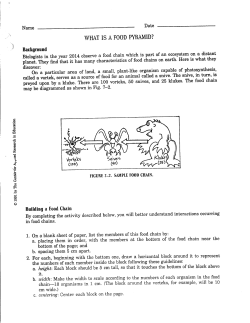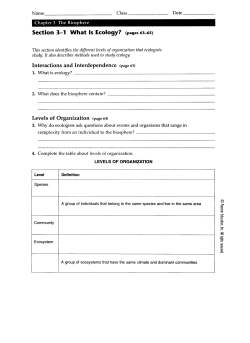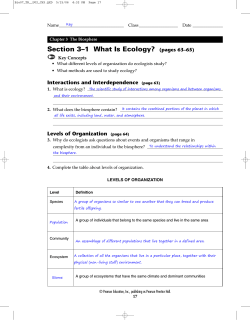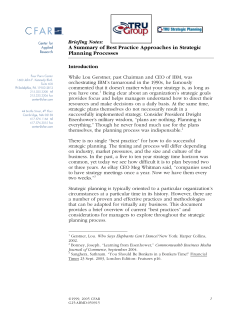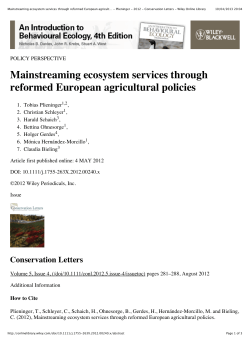
THE EcosysTEm 2 Structure 2.1
2 THE ecosystem 2.1 Structure pa ge s Assessment statements 2.1.1 Distinguish between biotic and abiotic (physical) components of an ecosystem. 2.1.2 Define the term trophic level. 2.1.3 Identify and explain trophic levels in food chains and food webs selected from the local environment. 2.1.4 Explain the principles of pyramids of numbers, pyramids of biomass, and pyramids of productivity, and construct such pyramids from given data. 2.1.5 Discuss how the pyramid structure affects the functioning of an ecosystem. 2.1.6 Define the terms species, population, habitat, niche, community and ecosystem with reference to local examples. 2.1.7 Describe and explain population interactions using examples of named species. e Biotic and abiotic components pl Biotic refers to the living components within an ecosystem (the community). Abiotic refers to the non-living factors of the ecosystem (the environment). Sa m Ecosystems consist of living and non-living components. Organisms (animals, plants, algae, fungi and bacteria) are the organic or living part of the ecosystem. The physical environment (light, air, water, temperature, minerals, soil and climatic aspects) constitute the non-living part. The living parts of an ecosystem are called the biotic components and the non-living parts the abiotic (not biotic) components. Abiotic factors include the soil (edaphic factors) and topography (the landscape). Biotic and non-biotic components interact to sustain the ecosystem. The word ‘environment’ refers specifically to the nonliving part of the ecosystem. To find links to hundreds of environmental sites, go to www.pearsonhotlinks.com, insert the express code 2630P and click on activity 2.1. To learn more about all things environmental, go to www.pearsonhotlinks.com, insert the express code 2630P and click on activity 2.2. Trophic levels, food chains and food webs The term ‘trophic level’ refers to the feeding level within a food chain. Food webs are made from many interconnecting food chains. Certain organisms in an ecosystem convert abiotic components into living matter. These are the producers; they support the ecosystem by producing new biological matter (biomass) (Figure 2.1). Organisms that cannot make their own food eat other organisms to obtain energy and matter. They are consumers. The flow of energy and matter from organism to organism can be shown in a food chain. The position that an organism occupies in a food chain is called the trophic level (Figure 2.2). Trophic level can also mean the position in the food chain occupied by a group of organisms in a community. 14 02_M02_14_82.indd 14 15/04/2010 08:53 solar energy Figure 2.1 Producers covert sunlight energy into chemical energy using photosynthetic pigments. The food produced supports the rest of the food chain. some light is reflected some wavelengths are unsuitable some light is transmitted photosynthesis changes solar energy to chemical energy energy lost through respiration biomass stores energy pa ge s Figure 2.2 A food chain. Ecosystems contain many food chains. producer primary consumer secondary consumer autotroph herbivore omnivore/carnivore tertiary consumer quaternary consumer carnivore carnivore m pl e Ecosystems contain many interconnected food chains that form food webs. There are a variety of ways of showing food webs, and they may include decomposers which feed on the dead biomass created by the ecosystem (Figure 2.3). The producer in this food web for the North Sea is phytoplankton (microscopic algae), the primary consumers (herbivores) are zooplankton (microscopic animal life), the secondary consumers (carnivores) include jellyfish, sand eels, and herring (each on different food chains), and the tertiary consumers (top carnivores) are mackerel, seals, seabirds and dolphins (again on different food chains). solar energy light available for photosynthesis Sa sea surface phytoplankton use disolved nutrients and carbon dioxide to photosynthesise Figure 2.3 A simplified food web for the North Sea in Europe. puffins, gannets zooplankton seals mackerel jellyfish sand eels herring dolphins squid cod, haddock continental shelf crustaceans feed on decaying organic material sea bed Diagrams of food webs can be used to estimate knock-on effects of changes to the ecosystem. During the 1970s, sand eels were harvested and used as animal feed, for fishmeal and for oil and food on salmon farms: Figure 2.3 can be used to explain what impacts a 15 02_M02_14_82.indd 15 15/04/2010 08:53 2 THE ECOSYSTEM dramatic reduction in the number of sand eels might have on the rest of the ecosystem. Sand eels are the only source of food for mackerel, puffin and gannet, so numbers of these species may decline or they may have to switch food source. Similarly, seals will have to rely more on herring, possibly reducing their numbers or they may also have to switch food source. The amount of zooplankton may increase, improving food supply for jellyfish and herring. Pyramids are graphical models showing the quantitative differences between the tropic levels of an ecosystem. There are three types. • Pyramid of numbers – This records the number of individuals at each trophic level. • Pyramid of biomass – This represents the biological mass of the standing stock at each trophic level at a particular point in time. • Pyramid of productivity – This shows the flow of energy (i.e. the rate at which the stock is being generated) through each trophic level. pl Sa m Stromatolites were the earliest producers on the planet and are still here. These large aggregations of cyanobacteria can be found in the fossil record and alive in locations such as Western Australia and Brazil. The earliest forms of life on Earth, 3.8 billion years ago, were consumers feeding on organic material formed by interactions between the atmosphere and the land surface. Producers appeared around 3 billion years ago – these were photosynthetic bacteria and their photosynthesis led to a dramatic increase in the amount of oxygen in the atmosphere. The oxygen enabled organisms that used aerobic respiration to generate the large amounts of energy they needed. And, eventually, complex ecosystems followed. e Examiner’s hint: You will need to find an example of a food chain from your local area, with named examples of producers, consumers, decomposers, herbivores, carnivores, and top carnivores. An estimated 1000 kg of plant plankton are needed to produce 100 kg of animal plankton. The animal plankton is in turn consumed by 10 kg of fish, which is the amount needed by a person to gain 1 kg of body mass. Biomass and energy decline at each successive trophic level so there is a limit to the number of trophic levels which can be supported in an ecosystem. Energy is lost as heat (produced as a waste product of respiration) at each stage in the food chain, so only energy stored in biomass is passed on to the next trophic level. Thus, after 4 or 5 trophic stages, there is not enough energy to support another stage. pa ge s Food chains always begin with the producers (usually photosynthetic organisms), followed by primary consumers (herbivores), secondary consumers (omnivores or carnivores) and then higher consumers (tertiary, quaternary, etc.). Decomposers feed at every level of the food chain. Pyramids of numbers, biomass and productivity Pyramids are graphical models of the quantitative differences that exist between the trophic levels of a single ecosystem. These models provide a better understanding of the workings of an ecosystem by showing the feeding relationship in a community. Pyramids of numbers The numbers of producers and consumers coexisting in an ecosystem can be shown by counting the numbers of organisms in an ecosystem and constructing a pyramid. Quantitative data for each trophic level are drawn to scale as horizontal bars arranged symmetrically around a central axis (Figure 2.4a). Sometimes, rather than counting every individual in a trophic level, limited collections may be done in a specific area and this multiplied up to the total area of the ecosystem. Pyramids of numbers are not always pyramid shaped; for example, in a woodland ecosystem with many insect herbivores feeding on trees, there are bound to be fewer trees than insects; this means the pyramid is inverted (upside-down) as in Figure 2.4b. This situation arises when the size of individuals at lower trophic levels are relatively large. Pyramids of numbers, therefore, have limitations in showing useful feeding relationships. 16 02_M02_14_82.indd 16 15/04/2010 08:54 (a) (a) (b)(b) top carnivores carnivores herbivores primary producers Figure 2.4 Pyramids of numbers. (a) A typical pyramid where the number of producers is high. (b) A limitation of number pyramids is that they are inverted when the number of producers is fewer than the number of herbivores. Pyramids of biomass pa ge s A pyramid of biomass quantifies the amount of biomass present at each trophic level at a certain point in time, and represents the standing stock of each trophic level measured in units such as grams of biomass per metre squared (g m–2). Biomass may also be measured in units of energy, such as joules per metre squared (J m–2). Following the second law of thermodynamics, there is a tendency for numbers and quantities of biomass and energy to decrease along food chains so the pyramids become narrower towards the top. pl e Although pyramids of biomass are usually pyramid shaped, they can sometimes be inverted and show greater quantities at higher trophic levels. This is because, as with pyramids of numbers, they represent the biomass present at a given time (i.e. they are a snap-shot of the ecosystem). The standing crop biomass (the biomass taken at a certain point in time) gives no indication of productivity over time. For example, a fertile intensively grazed pasture may have a lower standing crop biomass of grass but a higher productivity than a less fertile ungrazed pasture (the fertile pasture has biomass constantly removed by herbivores). This results in an inverted pyramid of biomass. In a pond ecosystem, the standing crop of phytoplankton (the major producers) at any given point will be lower than the mass of the consumers, such as fish and insects, as the phytoplankton reproduce very quickly. Inverted pyramids may also be the result of marked seasonal variations. m Both pyramids of numbers and pyramids of biomass represent storages. Pyramids of productivity Sa The turnover of two retail outlets cannot be compared by simply comparing the goods displayed on the shelves, because the rates at which the goods are sold and the shelves are restocked also need to be known. The same is true of ecosystems. Pyramids of biomass simply represent the momentary stock, whereas pyramids of productivity show the rate at which that stock is being generated. Pyramids of productivity take into account the rate of production over a period of time because each level represents energy per unit area per unit time. Biomass is measured in units of mass (g m–2) or energy (J m–2) as opposed to the more useful measurement of productivity in units of flow, mass or energy per metre squared per year (g m–2 yr–1 or J m–2 yr–1). Pyramids of productivity refer to the flow of energy through a trophic level and invariably show a decrease along the food chain. There are no inverted pyramids. The relative energy flow within an ecosystem can be studied, and different ecosystems can be compared. Pyramids of productivity also overcome the problem that two species may not have the same energy content per unit weight: in these cases, biomass is misleading but energy flow is directly comparable. Pyramid structure and ecosystem functioning Because energy is lost through food chains, top carnivores are at risk from disturbance further down the food chain. If there is a reduction in the numbers of producers or primary 17 02_M02_14_82.indd 17 15/04/2010 08:54 2 THE ECOSYSTEM consumers, existence of the top carnivores can be put at risk if there are not enough organisms (and therefore energy and biomass) to support them. Top carnivores may be the first population to noticeably suffer through ecosystem disruption. Case study Snow leopards are found in the mountain ranges of Central Asia. They feed on wild sheep and goats. Effects lower down the food chain threaten this top carnivore. Overgrazing of the mountain grasslands by farmed animals leaves less food for the snow leopard’s main prey: with less food for the wild sheep and goats, fewer of these animals are available for the snow leopard, which puts its existence at risk. The snow leopard has little choice but to prey on the domestic livestock in order to survive. But this leads the herdsmen to attack and kill the snow leopards. A snow leopard. e pl m Figure 2.5 Simple food chains showing the accumulation of the nonbiodegradable pesticide, DDT. Top carnivores can also be put at risk through other interferences in the food chain. Suppose a farmer uses pesticides to improve the crop yield and to maximize profits. Today’s pesticides break down naturally and lose their toxic properties (i.e. they are biodegradable), but this was not always the case. In the past, pesticides weren’t biodegradable, and they had serious knock-on effects for ecosystems. Figure 2.5 shows the effect of the very effective nonbiodegradable pesticide DDT on food chains. The producers, the algae and plants or grass (first accumulators) take in the DDT. The first trophic level (the primary consumers) eat the DDTcontaining producers and retain the pesticide in their body tissue (mainly in fat) – this is called bioaccumulation. The process continues up the food chain with more and more DDT being accumulated at each level. The top carnivores (humans, at level 6 in the aquatic food chain or level 3 in the terrestrial chain) are the final destination of the pesticide (ultimate accumulators). Sa To watch animations and learn more about ecological pyramids, go to www.pearsonhotlinks. com, insert the express code 2630P and click on activity 2.3. pa ge s The total wild population of the snow leopard is estimated at between 4100 and 6600 individuals, and they have now been designated as endangered by the International Union for Conservation of Nature (IUCN). Terrestrial sequence Aquatic sequence third carnivores (larger fish) milk meat second carnivores (larger fish) herbivores (grazing animals) humans, the ultimate accumulators first carnivores (larger fish) herbivores (smaller fish) grass algae and water plants DDT spray DDT spray The pesticide accumulates in body fat and is not broken down. Each successive trophic level supports fewer organisms, so the pesticide becomes increasingly concentrated in the tissues (this is called biomagnification). Organisms higher in the food chain also have progressively longer life spans so they have more time to accumulate more of the toxin by eating many DDT-containing individuals from lower levels. Top carnivores are therefore at risk from DDT poisoning. 18 02_M02_14_82.indd 18 15/04/2010 08:54 EXERCISES 1 Distinguish between biotic and abiotic factors. Which of these terms refers to the environment of an ecosystem? 2 What are the differences between a pyramid of biomass and a pyramid of productivity? Which is always pyramid shaped, and why? Give the units for each type of pyramid. 3 How can total biomass be calculated? 4 Why are non-biodegradable toxins a hazard to top predators in a food chain? 5 Why are food chains short (i.e. generally no more than five trophic levels in length)? What are the implications of this for the conservation of top carnivores? Species, populations, habitats and niches Ecological terms are precisely defined and may vary from the everyday use of the same words. Definitions for key terms are given below. pa ge s Species A species is defined as a group of organisms that interbreed and produce fertile offspring. If two species breed together to produce a hybrid, this may survive to adulthood but cannot produce viable gametes and so is sterile. An example of this is when a horse (Equus caballus) breeds with a donkey (Equus asinus) to produce a sterile mule. Sa m pl e The species concept cannot: • identify whether geographically isolated populations belong to the same species • classify species in extinct populations • account for asexually reproducing organisms • clearly define species when barriers to reproduction are incomplete (Figure 2.6). Vega herring gull Birula’s gull Examiner’s hint: • A pyramid of biomass represents biomass (standing stock) at a given time, whereas a pyramid of productivity represents the rate at which stocks are being generated (i.e. the flow of energy through the food chain). A pyramid of biomass is measured in units of mass (g m–2) or energy (J m–2); a pyramid of productivity is measured in units of flow (g m–2 yr–1 or J m–2 yr–1). • Because energy is lost through the food chain, pyramids of productivity are always pyramid shaped. Pyramids of number or biomass may be inverted because they represent only the stock at a given moment in time. The species concept is sometimes difficult to apply: for example, can it be used accurately to describe extinct animals and fossils? The term is also sometimes loosely applied to what are, in reality, sub-species that can interbreed. This is an example of an apparently simple term that is difficult to apply in practical situations. American herring gull Heuglin’s gull Siberian lesser black-backed gull lesser black -backed gull herring gull Figure 2.6 Gulls interbreeding in a ring around the Arctic are an example of ring species. Neighbouring species can interbreed to produce viable hybrids but herring gulls and lesser black-backed gulls, at the ends of the ring, cannot interbreed. Population A population is defined in ecology as a group of organisms of the same species living in the same area at the same time, and which are capable of interbreeding. 19 02_M02_14_82.indd 19 15/04/2010 08:54 2 THE ECOSYSTEM A population of zebras. Habitat pa ge s Habitat refers to the environment in which a species normally lives. For example, the habitat of wildebeest is the savannah and temperate grasslands of eastern and south-eastern Africa. Wildebeest in their habitat. To access worksheet 2.1 on mini-ecosystems, please visit www. pearsonbacconline.com and follow the on-screen instructions. pl m Sa of organisms that interbreed and produce fertile offspring. • Population – A group of organisms of the same species living in the same area at the same time, and which are capable of interbreeding. • Habitat – The environment in which a species normally lives. • Niche – Where and how a species lives. A species’ share of a habitat and the resources in it. • Community – A group of populations living and interacting with each other in a common habitat. • Ecosystem – A community of interdependent organisms and the physical environment they inhabit. e • Species – A group Niche An ecological niche is best be described as where, when and how an organism lives. An organism’s niche depends not only on where it lives (its habitat) but also on what it does. For example, the niche of a zebra includes all the information about what defines this species: its habitat, courtship displays, grooming, alertness at water holes, when it is active, interactions between predators and similar activities. No two different species can have the same niche because the niche completely defines a species. Community A community is a group of populations living and interacting with each other in a common habitat. This contrasts with the term ‘population’ which refers to just one species. The grasslands of Africa contain wildebeest, lions, hyenas, giraffes and elephants as well as zebras. Communities include all biotic parts of the ecosystem, both plants and animals. Ecosystem An ecosystem is a community of interdependent organisms (the biotic component) and the physical environment (the abiotic component) they inhabit. 20 02_M02_14_82.indd 20 15/04/2010 08:54 Population interactions Ecosystems contain numerous populations with complex interactions between them. The nature of the interactions varies and can be broadly divided into four types (competition, predation, parasitism and mutualism), each of which is discussed below. Examiner’s hint: You must be able to define the terms species, population, habitat, niche, community and ecosystem and apply them to examples from your local area. Competition When resources are limiting, populations are bound to compete in order to survive. This competition can be either within a species (intraspecific competition) or between different species (interspecific competition). Interspecific competition exists when the niches of different species overlap (Figure 2.7). No two species can occupy the same niche, so the degree to which niches overlap determines the degree of interspecific competition. In this relationship, neither species benefit, although better competitors suffer less. species A pa ge s proportion of individuals species B species C body size Figure 2.7 The niches of species A and species B, based on body size, overlap with each other to a greater extent than with species C. Strong interspecific competition will exist between species A and B but not with species C. P. aurelia m P. caudatum P. aurelia P. caudatum Sa (a) population population density density (a) pl e Experiments with single-celled animals have demonstrated the principle of competitive exclusion: if two species occupying similar niches are grown together, the poorer (a) competitor will be eliminated (Figure 2.8). 0 2 4 6 8 days 10 12 14 16 18 0 2 4 6 8 days 10 12 14 16 18 16 18 16 18 (b) population population density density (b) (b) Figure 2.8 Species of Paramecium can easily be gown in the laboratory. (a) If two species with very similar resource needs (i.e. similar niches) are grown separately, both can survive and flourish. (b) If the two species are grown in a mixed culture, the superior competitor – in this case P. aurelia – will eliminate the other. P. aurelia P. aurelia P. caudatum 0 2 4 6 8 days 10 0 2 4 6 8 days 10 P. caudatum 12 14 12 14 Individuals within the same species occupy the same niche. Thus, if resources become limiting for a population, intraspecific competition becomes stronger. 21 02_M02_14_82.indd 21 15/04/2010 08:54 2 THE ECOSYSTEM Predation Predation occurs when one animal (or, occasionally, a plant) hunts and eats another animal. These predator–prey interactions are often controlled by negative feedback mechanisms that control population densities (e.g. the snowshoe hare and lynx, page 8). Nepenthes rajah, the largest pitcher plant, can hold up to 3.5 litres of water in the pitcher and has been known to trap and digest small mammals such as rats. Nepenthes rajah is endemic to Mount Kinabalu where it lives between 1500 and 2650 m above sea level (pages 66–67). pl Parasitism e pa ge s Not all predators are animals. Insectivorous plants, such as the Venus fly traps and pitcher plants trap insects and feed on them. Such plants often live in areas with nitratepoor soils and obtain much of their nitrogen from animal protein. Rafflesia have the largest flowers in the world but no leaves. Without leaves, they cannot photosynthesize, so they grow close by SouthEast Asian vines (Tetrastigma spp.) from which they draw the sugars they need for growth. Sa m In this relationship, one organism (the parasite) benefits at the expense of another (the host) from which it derives food. Ectoparasites live on the surface of their host (e.g. ticks and mites); endoparasites live inside their host (e.g. tapeworms). Some plant parasites draw food from the host via their roots. Mutualism Symbiosis is a relationship in which two organisms live together (parasitism is a form of symbiosis where one of the organisms is harmed). Mutualism is a symbiotic relationship in which both species benefit. Examples include coral reefs and lichens. Coral reefs show a symbiotic relationship between the coral animal (polyp) and zooxanthellae (unicellular brown algae or dinoflagellates) that live within the coral polyp (Figure 2.9). 22 02_M02_14_82.indd 22 15/04/2010 08:54 zooxanthellae mouth tenticles with nematocysts (stinging cells) Figure 2.9 The zooxanthellae living within the polyp animal photosynthesize to produce food for themselves and the coral polyp, and in return are protected. Mutualism is a symbiotic relationship in which both species benefit. nematocyst gastrovascular cavity (digestive sac) Parasitism is a symbiotic relationship in which one species benefits at the expense of the other. pa ge s living tissue linking polyps skeleton Sa m pl e limestone calice Lichens consist of a fungus and alga in a symbiotic relationship. The fungus is efficient at absorbing water but cannot photosynthesize, whereas the alga contains photosynthetic pigments and so can use sunlight energy to convert carbon dioxide and water into glucose. The alga therefore obtains water and shelter, and the fungus obtains a source of sugar from the relationship. Lichens with different colours contain algae with different photosynthetic pigments. EXERCISES 1 Define the terms species, population, habitat, niche, community, and ecosystem. What is the difference between a habitat and a niche? Can different species occupy the same niche? 2 What is the difference between mutualism and parasitism? Give examples of each. 3 The abundance of one species can affect the abundance of another. Give an ecological example of this, and explain how the predator affects the abundance of the prey, and vice versa. Are population numbers generally constant in nature? If not, what implications does this have for the measurement of wild population numbers? 23 02_M02_14_82.indd 23 15/04/2010 08:54 2 THE ECOSYSTEM 2.2 Measuring abiotic components of the system Assessment statements 2.2.1 List the significant abiotic (physical) factors of an ecosystem. 2.2.2 Describe and evaluate methods for measuring at least three abiotic (physical) factors within an ecosystem. Measuring abiotic components pa ge s Ecosystems can be broadly divided into three types. • Marine – The sea, estuaries, salt marshes and mangroves are all characterized by the high salt content of the water. • Freshwater – Rivers, lakes and wetlands. • Terrestrial – Land-based. Each ecosystem has its own specific abiotic factors (listed below) as well as the ones they share. Abiotic factors of a marine ecosystem: • salinity • pH • temperature • dissolved oxygen • wave action. m pl e Estuaries are classified as marine ecosystems because they have high salt content compared to freshwater. Mixing of freshwater and oceanic sea water leads to diluted salt content but it is still high enough to influence the distribution of organisms within it – salt-tolerant animals and plants have specific adaptations to help them cope with the osmotic demands of saltwater. Sa Only a small proportion of freshwater is found in ecosystems (Figure 2.10). Abiotic factors of a freshwater ecosystem: • temperature • turbidity • flow velocity • dissolved oxygen • pH. Figure 2.10 The majority of the Earth’s freshwater is locked up in ice and snow, and is not directly available to support life. Groundwater is a store of water beneath ground and again is inaccessible for living organisms. permafrost 0.86% fresh groundwater 30.1% lakes 0.26% soil moisture 0.05% wetlands 0.03% rivers 0.006% ice and snow 68.7% 24 02_M02_14_82.indd 24 15/04/2010 08:54 Abiotic factors of a terrestrial ecosystem: • temperature • light intensity • wind speed • particle size • slope/aspect • soil moisture • drainage • mineral content. pl e pa ge s The Nevada desert, USA. Water supply in terrestrial ecosystems can be extremely limited, especially in desert areas, and is an important abiotic factor in controlling the distribution of organisms. Sa m You must know methods for measuring each of the abiotic factors listed above and how they might vary in any given ecosystem with depth, time or distance. Abiotic factors are examined in conjunction with related biotic components (pages 29–34). This allows species distribution data to be linked to the environment in which they are found and explanations for the patterns to be proposed. To learn more about sampling techniques, go to www.pearson.co.uk, insert the express code 2630P and click on activity 2.4. Distribution of Earth’s water fresh water 3% other 0.9% surface water 0.3% rivers 2% swamps 11% groundwater 30.1% saltwater 97% icecaps and glaciers 68.7% Earth’s water fresh water lakes 87% fresh surface water The majority of the Earth’s water is found in the oceans, with relatively little in lakes and rivers. Much of the freshwater that does exist is stored in ice at the poles (Figures 2.10 and 2.11). Figure 2.11 The percentage of the planet containing freshwater ecosystems is extremely low compared to oceanic ones. 25 02_M02_14_82.indd 25 15/04/2010 08:55 2 THE ECOSYSTEM Evaluating measures for describing abiotic factors This section examines the techniques used for measuring abiotic factors. An inaccurate picture of an environment may be obtained if errors are made in sampling: possible sources of error are examined below. Light A light-meter can be used to measure the light in an ecosystem. It should be held at a standard and fixed height above the ground and read when the value is fixed and not fluctuating. Cloud cover and changes in light intensity during the day mean that values must be taken at the same time of day and same atmospheric conditions: this can be difficult if several repeats are taken. The direction of the light-meter also needs to be standardized so it points in the same direction at the same angle each time it is used. Care must be taken not to shade the light-meter during a reading. pa ge s Abiotic factors that can be measured within an ecosystem include the following. • Marine environment – Salinity, pH, temperature, dissolved oxygen, wave action. • Freshwater environment – Turbidity, flow velocity, pH, temperature, dissolved oxygen. • Terrestrial environment – Temperature, light intensity, wind speed, particle size, slope, soil moisture, drainage, mineral content. Temperature Ordinary mercury thermometers are too fragile for fieldwork, and are hard to read. An electronic thermometer with probes (datalogger) allows temperature to be measured in air, water, and at different depths in soil. The temperature needs to be taken at a standard depth. Problems arise if the thermometer is not buried deeply enough: the depth needs to be checked each time it is used. e pH Sa m pl This can be measured using a pH meter or datalogging pH probe. Values in freshwater range from slightly basic to slightly acidic depending on surrounding soil, rock and vegetation. Sea water usually has a pH above 7 (alkaline). The meter or probe must be cleaned between each reading and the reading taken from the same depth. Soil pH can be measured using a soil test kit – indicator solution is added and the colour compared to a chart. Wind Measurements can be taken by observing the effects of wind on objects – these are then related to the Beaufort scale. Precise measurements of wind speed can be made with a digital anemometer. The device can be mounted or hand-held. Some use cups to capture the wind whereas other smaller devices use a propeller. Care must be taken not to block the wind. Gusty conditions may lead to large variations in data. Particle size An anemometer measuring wind speed. It works by converting the number of rotations made by three cups at the top of the apparatus into wind speed. Soil can be made up of large, small or intermediate particles. Particle size determines drainage and water-holding capacity (page 125). Large particles (pebbles) can be measured individually and the average particle size calculated. Smaller particles can be measured by using a series of sieves with increasingly fine mesh size. The smallest particles can be separated by sedimentation. Optical techniques (examining the properties of light scattered by a suspension of soil in water) can also be used to study the smallest particles. The best techniques are expensive and the simpler ones time consuming. 26 02_M02_14_82.indd 26 15/04/2010 08:55
© Copyright 2025

